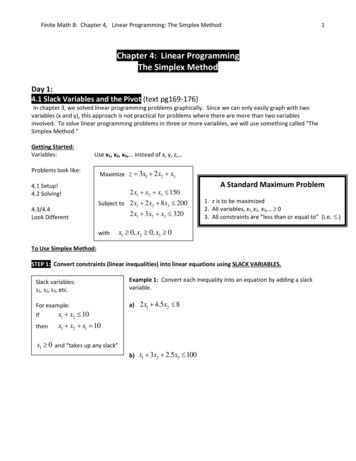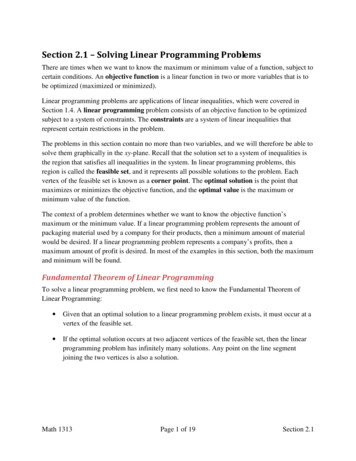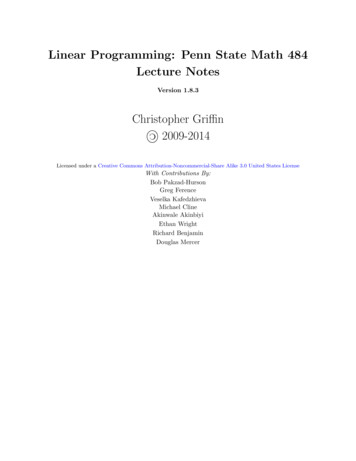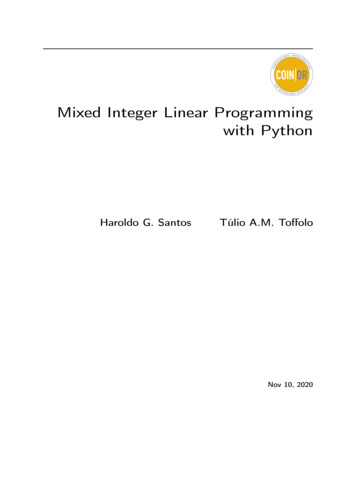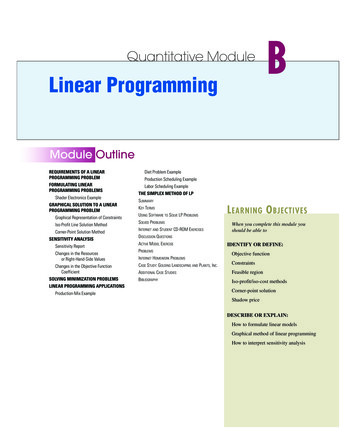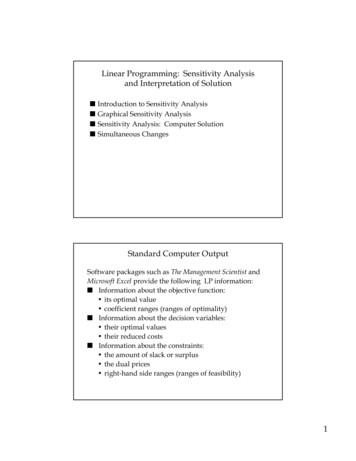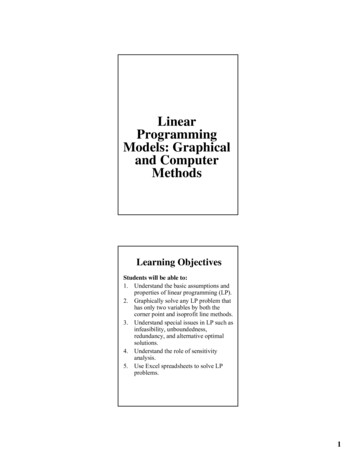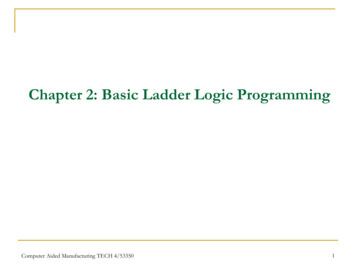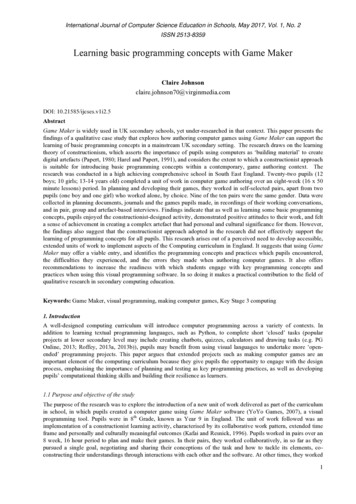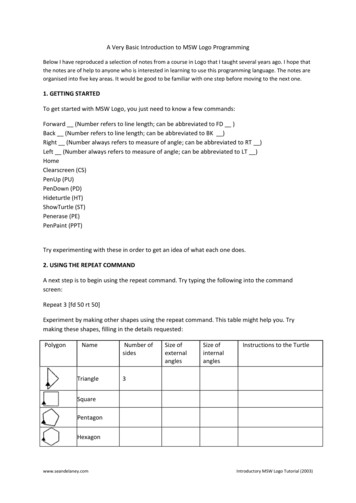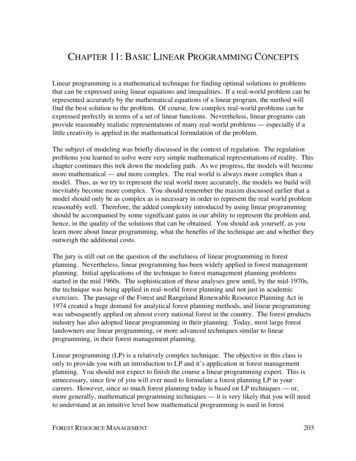
Transcription
CHAPTER 11: BASIC LINEAR PROGRAMMING CONCEPTSLinear programming is a mathematical technique for finding optimal solutions to problemsthat can be expressed using linear equations and inequalities. If a real-world problem can berepresented accurately by the mathematical equations of a linear program, the method willfind the best solution to the problem. Of course, few complex real-world problems can beexpressed perfectly in terms of a set of linear functions. Nevertheless, linear programs canprovide reasonably realistic representations of many real-world problems — especially if alittle creativity is applied in the mathematical formulation of the problem.The subject of modeling was briefly discussed in the context of regulation. The regulationproblems you learned to solve were very simple mathematical representations of reality. Thischapter continues this trek down the modeling path. As we progress, the models will becomemore mathematical — and more complex. The real world is always more complex than amodel. Thus, as we try to represent the real world more accurately, the models we build willinevitably become more complex. You should remember the maxim discussed earlier that amodel should only be as complex as is necessary in order to represent the real world problemreasonably well. Therefore, the added complexity introduced by using linear programmingshould be accompanied by some significant gains in our ability to represent the problem and,hence, in the quality of the solutions that can be obtained. You should ask yourself, as youlearn more about linear programming, what the benefits of the technique are and whether theyoutweigh the additional costs.The jury is still out on the question of the usefulness of linear programming in forestplanning. Nevertheless, linear programming has been widely applied in forest managementplanning. Initial applications of the technique to forest management planning problemsstarted in the mid 1960s. The sophistication of these analyses grew until, by the mid-1970s,the technique was being applied in real-world forest planning and not just in academicexercises. The passage of the Forest and Rangeland Renewable Resource Planning Act in1974 created a huge demand for analytical forest planning methods, and linear programmingwas subsequently applied on almost every national forest in the country. The forest productsindustry has also adopted linear programming in their planning. Today, most large forestlandowners use linear programming, or more advanced techniques similar to linearprogramming, in their forest management planning.Linear programming (LP) is a relatively complex technique. The objective in this class isonly to provide you with an introduction to LP and it’s application in forest managementplanning. You should not expect to finish the course a linear programming expert. This isunnecessary, since few of you will ever need to formulate a forest planning LP in yourcareers. However, since so much forest planning today is based on LP techniques — or,more generally, mathematical programming techniques — it is very likely that you will needto understand at an intuitive level how mathematical programming is used in forestFOREST RESOURCE MANAGEMENT203
CHAPTER 11: BASIC LINEAR PROGRAMMING CONCEPTSmanagement planning. By the end of the course, you should have a basic understanding ofhow LP works; you should be able to formulate a small forest management planning problemas an LP; and you should be able to interpret the LP solution of a forest managementplanning problem. This background will help you understand modern forest planning betterso you can be a better participant in forest planning processes and so you will feel morecomfortable implementing forest plans that are based on mathematical programmingtechniques. Finally, you should understand the process of mathematical programming wellenough to recognize some of the potential problems and pitfalls of applying these techniques.1. A Brief Introduction to Linear ProgrammingLinear programming is not a programming language like C , Java, or Visual Basic. Linearprogramming can be defined as:“A mathematical method to allocate scarce resources to competing activitiesin an optimal manner when the problem can be expressed using a linearobjective function and linear inequality constraints.”A linear program consists of a set of variables, a linear objective function indicating thecontribution of each variable to the desired outcome, and a set of linear constraints describingthe limits on the values of the variables. The “answer” to a linear program is a set of valuesfor the problem variables that results in the best — largest or smallest — value of theobjective function and yet is consistent with all the constraints. Formulation is the process oftranslating a real-world problem into a linear program. Once a problem has been formulatedas a linear program, a computer program can be used to solve the problem. In this regard,solving a linear program is relatively easy. The hardest part about applying linearprogramming is formulating the problem and interpreting the solution.Linear EquationsAll of the equations and inequalities in a linear program must, by definition, be linear. Alinear function has the following form:a0 a1 x1 a2 x2 a3 x3 . . . an xn 0In general, the a’s are called the coefficients of the equation; they are also sometimes calledparameters. The important thing to know about the coefficients is that they are fixed values,based on the underlying nature of the problem being solved. The x’s are called the variablesof the equation; they are allowed to take on a range of values within the limits defined by theconstraints. Note that it is not necessary to always use x’s to represent variables; any labelcould be used, and more descriptive labels are often more useful.FOREST RESOURCE MANAGEMENT204
CHAPTER 11: BASIC LINEAR PROGRAMMING CONCEPTSLinear equations and inequalities are often written using summation notation, which makes itpossible to write an equation in a much more compact form. The linear equation above, forexample, can be written as follows:a0 n a i xii 1 0Note that the letter i is an index, or counter, that starts in this case at 1 and runs to n. There isa term in the sum for each value of the index. Just as a variable does not have to be specifiedwith a letter x, the index does not have to be a letter i. Summation notation will be used a lotin the rest of this chapter and in all of the remaining chapters. You will need to become adeptat interpreting it.The Decision VariablesThe variables in a linear program are a set of quantities that need to be determined in order tosolve the problem; i.e., the problem is solved when the best values of the variables have beenidentified. The variables are sometimes called decision variables because the problem is todecide what value each variable should take. Typically, the variables represent the amount ofa resource to use or the level of some activity. For example, a variable might represent thenumber of acres to cut from a particular part of the forest during a given period. Frequently,defining the variables of the problem is one of the hardest and/or most crucial steps informulating a problem as a linear program. Sometimes creative variable definition can beused to dramatically reduce the size of the problem or make an otherwise non-linear problemlinear.As mentioned earlier, a variety of symbols, with subscripts and superscripts as needed, can beused to represent the variables of an LP. As a general rule, it is better to use variable namesthat help you remember what the variable represents in the real world. For this generalintroduction, the variables will be represented — very abstractly — as X1 , X2 , . . ., Xn . (Notethat there are n variables in this list.)The Objective FunctionThe objective of a linear programming problem will be to maximize or to minimize somenumerical value. This value may be the expected net present value of a project or a forestproperty; or it may be the cost of a project; it could also be the amount of wood produced, theexpected number of visitor-days at a park, the number of endangered species that will besaved, or the amount of a particular type of habitat to be maintained. Linear programming isan extremely general technique, and its applications are limited mainly by our imaginationsand our ingenuity.FOREST RESOURCE MANAGEMENT205
CHAPTER 11: BASIC LINEAR PROGRAMMING CONCEPTSThe objective function indicates how each variable contributes to the value to be optimized insolving the problem. The objective function takes the following general form:nmaximize or minimize Z ci X ii 1where ci the objective function coefficient corresponding to the ith variable, andXi the ith decision variable.1The coefficients of the objective function indicate the contribution to the value of theobjective function of one unit of the corresponding variable. For example, if the objectivefunction is to maximize the present value of a project, and Xi is the ith possible activity in theproject, then ci (the objective function coefficient corresponding to Xi ) gives the net presentvalue generated by one unit of activity i. As another example, if the problem is to minimizethe cost of achieving some goal, Xi might be the amount of resource i used in achieving thegoal. In this case, ci would be the cost of using one unit of resource i.Note that the way the general objective function above has been written implies that there is acoefficient in the objective function corresponding to each variable. Of course, somevariables may not contribute to the objective function. In this case, you can either think ofthe variable as having a coefficient of zero, or you can think of the variable as not being inthe objective function at all.The ConstraintsConstraints define the possible values that the variables of a linear programming problemmay take. They typically represent resource constraints, or the minimum or maximum levelof some activity or condition. They take the following general form:nsubject to a j ,i X i b jj 1, 2,., mi 1where Xi the ith decision variable,aj, i the coefficient on Xi in constraint j, andbj the right-hand-side coefficient on constraint j.Note that j is an index that runs from 1 to m, and each value of j corresponds to a constraint.Thus, the above expression represents m constraints (equations, or, more precisely,1The summation notation used here was discussed in the section above on linear functions. Thesummation notation for the objective function can be expanded out as follows:nZ ci X i c1 X 1 c2 X 2 c3 X 3 . cn X ni 1FOREST RESOURCE MANAGEMENT206
CHAPTER 11: BASIC LINEAR PROGRAMMING CONCEPTSinequalities) with this form. Resource constraints are a common type of constraint. In aresource constraint, the coefficient aj, i indicates the amount of resource j used for each unitof activity i, as represented by the value of the variable Xi . The right-hand side of theconstraint (bj ) indicates the total amount of resource j available for the project.Note also that while the constraint above is written as a less-than-or-equal constraint, greaterthan-or-equal constraints can also be used. A greater-than-or-equal constraint can always beconverted to a less-than-or-equal constraint by multiplying it by -1. Similarly, equalityconstraints can be written as two inequalities — a less-than-or-equal constraint and a greaterthan-or-equal constraint.The Non-negativity ConstraintsFor technical reasons beyond the scope of this book, the variables of linear programs mustalways take non-negative values (i.e., they must be greater than or equal to zero). In mostcases, where, for example, the variables might represent the levels of a set of activities or theamounts of some resource used, this non-negativity requirement will be reasonable – evennecessary. In the rare case where you actually want to allow a variable to take on a negativevalue there are certain formulation “tricks” that can be employed. These “tricks” also arebeyond the scope of this class, however, and all of the variables we will use will only need totake on non-negative values. In any case, the non-negativity constraints are part of all LPformulations, and you should always include them in an LP formulation. They are written asfollows:Xi 0 i 1, 2, . . ., nwhere Xi the ith decision variable.A General Linear Programming ProblemAt this point, all of the pieces of a general linear programming problem have been discussed.It may be useful to put all of the pieces together. All LP problems have the following generalform:nmaximize or minimize Z ci X ii 1nsubject to a j ,i X i b jj 1, 2,., mi 1andXi 0 i 1, 2, . . ., nwhere Xi the ith decision variable,FOREST RESOURCE MANAGEMENT207
CHAPTER 11: BASIC LINEAR PROGRAMMING CONCEPTSci the objective function coefficient corresponding to the ith variable,aj, i the coefficient on Xi in constraint j, andbj the right-hand-side coefficient on constraint j.Now that you have a general idea – albeit, an abstract one – of the structure of a linearprogram, the next step is to consider the process of formulating a linear programmingproblem. The following section walks you through the process of formulating two exampleproblems. This should help give you a more concrete idea of what a linear program is.2. Linear Programming Problem FormulationWe are not going to be concerned in this class with the question of how LP problems aresolved. Instead, we will focus on problem formulation — translating real-world problemsinto the mathematical equations of a linear program — and interpreting the solutions to linearprograms. We will let the computer solve the problems for us.This section introduces you to the process of formulating linear programs. The basic steps informulation are:1. Identify the decision variables;2. Formulate the objec
05.11.1998 · Linear programming is a mathematical technique for finding optimal solutions to problems that can be expressed using linear equations and inequalities. If a
